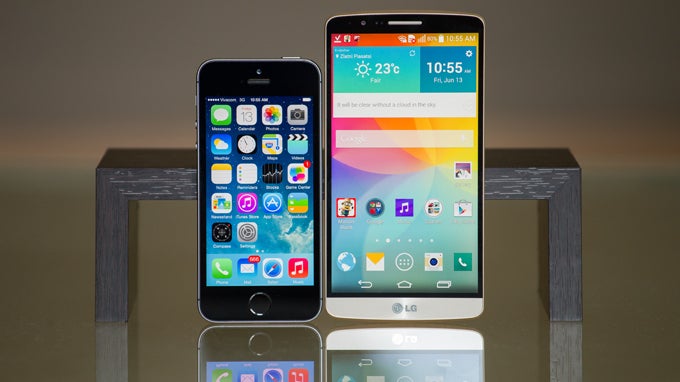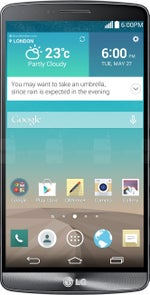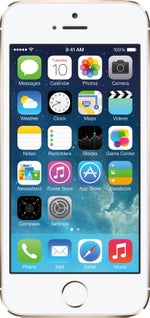LG G3 vs Apple iPhone 5s

Introduction
LG's flagship for the year, the G3, is stuffed to the gills with modern specs, and even throws a thrill or two, in the form of a display with record pixel density, and a unique laser autofocus system. Apple's iPhone 5s, on the other hand, offers a more manageable chassis, and a stellar Touch ID fingerprints sensor. As usual, we are staging a combat between the brushed looks of the 5.5” LG G3, against the slender metal-and-glass frame of the iPhone 5s, as this will be one of the heavyweights fight in the Android vs iOS championship for the immediate future. Which one will prevail? Let's find out...
UPDATE (Jun 25, 2014): This comparison was originally based on our experience with the Korean version of the LG G3. After testing the International (European) version of the phone, we've updated the story with our new findings, affecting the display, camera and battery performance.
Design
The plastic G3 feels less premium to hold, and is much harder to use with one hand than the iPhone 5s - those get traded for the large 5.5” display.
The phones are in entirely different categories when it comes to external design. Measuring at 8.9 mm, the 5.5” G3 is thicker than the 4” iPhone 5s (7.6 mm), and way larger, heavier, and cumbersome to use with one hand. Its plastic build sports a removable back cover, giving you access to the battery compartment and memory expansion slot – possibilities that the iPhone 5s doesn't offer. The iPhone is crafted in a very different way, with premium metal chassis.
LG has positioned the power/lock key, and the volume rocker, in its unique way on the back of the handset. Here they are easier to feel and press with your index finger only, and ensure good tactile feedback. The lock key and the volume buttons of the iPhone 5s are also breezy to use, on account of the small form factor of the phone, which lets your fingers reach everywhere without stretch gymnastics.
Apple shook the mobile phone industry with a unique Touch ID sensor embedded in the home key, which is the first (and only) fingerprint sensor on a mobile device done right. It lets you unlock the phone, and authorize iTunes purchases.
Display
The Quad HD panel of the G3 overpowers the smallish display on the iPhone 5s with sheer size and record pixel density, but is less visible outdoors.
The G3 has a 5.5" Quad HD (1440x2560 pixels) IPS-LCD display with record 538ppi pixel density, while the 4" 640x1136 pixels IPS-LCD display on the iPhone has only 326ppi. You won't be able to notice the individual pixels on both displays from a normal viewing distance, but if you examine the screens closely, the G3 panel comes out significantly sharper.
The iPhone 5s has excellent color reproduction with very accurate colors. In comparison, the G3 display colors are less correct, which goes especially for the oversatured reds, but not something that the average user will notice, unlike with Samsung's tacky AMOLED displays, for instance. The color temperatures of both handsets are pretty close – we measured 7099K for the G3, against the iPhone's 7144K. Both are near enough to the 6500K white point standard, so we can't say that either of them leans to the cold side of the spectrum. When it comes to outdoor visibility, though, the iPhone 5s definitely has the upper hand, as it is capable to reach almost 600 nits of peak brightness, and has lower reflectance, while the G3 musters 455 nits only.
Interface
The G3 offers a more versatile interface, with a steeper learning curve, compared to the simplified iOS 7 on the iPhone 5s.
With the G3, LG has toned down its customized Optimus UI experience, layered on top of Android 4.4.2 KitKat, when compared to the previous versions. It is flatter and simpler visually now, with a pretty uniform look, and color-coded sections, but its responsiveness seems sluggish at times. The G3 offers unique features like Knock Code, the QSlide floating apps, and the Dual Windows mode, which comes very handy on the big-screen handset, as it splits it in two, letting you run two apps at the same time. Needless to say, the big screen is a liability when you try to use the keyboard or the dialer with one hand, compared to the compact iPhone 5s. LG has provided a way to remedy this somewhat by shrinking the keyboard to the side of the screen, so you can reach any letter with your thumb only.
The iPhone runs iOS 7.1, which exhibits flat, colorful icons, and handy drop-down notification bar, which is inhabited by your most pertinent new info. We also get a pull-up Command Center, rich in connectivity toggles, and a screen brightness slider. Apple's approach doesn't bet on a widget system, and doesn't offer any split-screen multitasking, or floating apps. Apple provides its Siri voice-controlled assistant, which is countered with Google Voice on the G3, and the two offer similar functionality for those who are bent on using their vocal cords to manage their handset. The iPhone 5s has the excellent Passbook application, which aggregates your digital coupons, airline and train tickets, movie passes and rewards and gift cards, while Google's Android has yet to reply to iOS on this feature.
Processor and memory
The G3 feels a tad sluggish at times, maxing out its Snapdragon 801 CPU, while Apple's 64-bit A7 rockets through the iOS interface.
The G3 sports a 2.5 GHz quad-core Snapdragon 801 processor, coupled with Adreno 330 GPU, and has a 2 GB/16 GB and 3 GB/32 GB variations. Apple strikes back with a 64-bit A7 processing chip in its handset, and 1 GB of RAM. Both processors are so fast, that there is barely any app out there, including heavy 3D games, that would make them break a sweat, but the Optimus UI, as found on the G3, feels testy at times. The 5s has 16 GB of internal memory from the box, with additional storage options available for extra money, and it doesn't carry a memory card slot, unlike the G3.
Internet and connectivity
We can attest for stellar browsing experience on both devices, with fast and smooth scrolling, panning around and zooming in or out. The Reading mode in Safari on the iPhone 5s strips webpages of distracting content like pics and ads, and presents you the article in a clear text format for easier reading. It doesn't support Adobe Flash, which can be sideloaded on the default G3 browser for those situations you might need it. Surfing the web on the larger display of LG's phone, is, naturally, more enjoyable, due to the sheer screen size advantage.
The handsets have multiband LTE and 3G radios, depending on the area they are sold in, as well as a suite of other connectivity options, such as Wi-Fi, Bluetooth 4.0, A-GPS, and DLNA streaming. The LG G3 adds NFC and wireless charging to the mix, too. LG also offers an infrared port at the top, which is used to command home electronics like TVs, stereos, set-top boxes, and even AC units of various brands. Wired connectivity is done via the convenient side-agnostic Lightning port on the iPhone 5s, and a SlimPort on the G3, for TV-out scenarios with the respective adapter.
Camera
The G3 offers laser autofocus and many shooting modes, yet its picture quality is on par with the iPhone 5s, though LG takes the video round with 4K footage and OIS.
LG G3 comes with a 13-megapixel camera with 1/3.06” sensor, 1.1-micron pixels, and f/2.4 aperture, optical image stabilization and a two-tone flash. In comparison, Apple has placed an 8 MP sensor of the same 1/3.06” size, allowing for larger, 1.5-micron pixels in the iPhone 5s, plus a two-tone LED flash in its turn. The 5s has a tad wider f/2.2 aperture, and a five-element lens with 31 mm focal length.
The G3 shooter also sports a unique infrared laser emitter on the back, which helps speed up focusing to 0.276s. This means that shooting is very fast, as the G3 takes no more than a second to snap one shot and be ready for the next shutter press. The iPhone 5s' autofocus times have been measured to be between 0.5 – 1 second, depending on the light situation, which is slower than the G3, but also feels very fast.
The G3 camera app offers an abundance of color effects and shooting modes, like auto HDR and the Magic Focus camera option that will capture at different focus settings, leading to a blurred-out background for more artsy photos. Apple's simple, easy to use camera app interface consists only of a few main options, such as Panorama and now-automatic HDR capture, but their execution is fast and flawless. Moreover, you can always achieve most of the modes present on the G3 with 3rd party iOS apps, including the out-of-focus effect.
The iPhone 5s has consistently delivered great results in our camera comparisons, so how does it fare against the new G3? For starters, both phones deliver great images, but color reproduction could have been more accurate – both the G3 and the 5s have warm color overcast in the pictures. The 13 MP camera of the LG G3 manages to capture a very good level of detail, resolving more than the 8 MP shooter of the iPhone 5s.
Indoors, the G3 camera often chooses too slow of a shutter speed – this allows it to take photos without firing the flash, but may result in a tad blurry image due to hand shake. Other than that, indoor shots taken with the G3 are very good. The amount of noise is kept in check, the photos are detailed, plus the LED flash is very strong, and distributes the light evenly throughout the scene, without ruining the color balance. What we noticed, however, is that under the artificial lighting in our studio, the G3 tends to produce photos with warm tint to them. The indoor photos from the iPhone 5s are detailed, but a bit warmer than they should be, too, and noise sometimes creeps up when the two-tone LED flash decides to stay put. The iPhone's flash also illuminates the scene evenly, though it's a tad weaker than the potent lights on the back of the G3.
LG's phone can record ultra high-res 4K video at 30fps, as well as 1080p video, while the iPhone 5s makes do with 1080p only, which, however, is more than adequate for any purpose. The G3 video is fluid, very steady on account of the OIS mechanism, and sports quick exposure adjustments while panning around. The iPhone 5s produces a smooth and vivid footage, too, though you need to tap on the screen to make the phone focus on closer objects, as it doesn't do it automatically. Footage from LG's phone looks a tad more vivid and saturated, and with a step lighter exposure than what the iPhone 5s captures. The G3 records a very strong sound to accompany the videos, though not as clean as the iPhone 5s musters.
Multimedia
The much larger display and wider codec support of the G3 make for a richer multimedia experience.
The iPhone 5s gallery, as well as the one on the G3, offer grid thumbnail view of your photos and videos. LG lets you pinch-to-resize the thumbs in the gallery, but the editing options aren't built-in, unlike the photo editing on the iPhone 5s. Instead, upon pressing the edit button, LG offers you to take the action either to Google Photos, or the preloaded Photo Punch application, which has a tailored editing interface.
The music players sport categorization options by artists, albums or playlists, but the sound and equalizer effects on the G3 are built into the player's interface, while on the 5s you have to go to the general settings app to change them. The LG G3 has an amplified 1W speaker on the back, which still doesn't sound as strong and full as the loudspeaker that Apple equipped on the iPhone 5s.
Video playback on the large display of the LG G3 is a very enjoyable experience, especially considering that the stock player runs everything you throw at it, at up to the whopping 2K resolutions, while on the iPhone 5s you have to convert many popular formats before they can be played back. LG's video player is also feature-rich, letting you add subtitles, captions, or detaching it, and playing the video in a small window, while doing something else with the phone.
Call quality
The iPhone sports great call quality on both sides of the line, with the G3 being a worthy runner-up.
The LG G3 has two noise-canceling mics, which relayed our voice without hiss and digitization to the other end, plus the sound remained strong and voice timbres recognizable. On our side, the earpiece showed adequate strength, and the voices sounded true to form.
Apple's iPhone 5s offers three mics for noise-cancellation, and the voices relayed on the other side are strong, clear, and free of high-pitched distortions or ambient noise. Its earpiece is also very clean and powerful.
Battery life
LG G3 showed average battery life, though still higher endurance than the iPhone 5s.
LG placed a 3000 mAh battery in the G3, with the so-called “Adaptive” set of technologies for the screen framerate and the processor clocks. Officially, it pegs the G3 as capable of up to 23 days of standby in 3G mode, and 25 when connected to an LTE network. The talk times given is 21 hours in 3G mode, which is a very good result. In our own battery endurance test, the G3 mustered longer endurance than the iPhone 5s - 6 hours and 14 minutes, which is a decent achievement.
Apple cites 10 hours of talk time for the iPhone 5s in 3G mode, and in our battery test the handset lasts a bit over 5 hours of screen-on time with its embedded 1570 mAh unit, meaning that you are likely to have it charged daily with normal usage.
Apple cites 10 hours of talk time for the iPhone 5s in 3G mode, and in our battery test the handset lasts a bit over 5 hours of screen-on time with its embedded 1570 mAh unit, meaning that you are likely to have it charged daily with normal usage.
Conclusion
The LG G3 and the iPhone 5s not only seem worlds apart when it comes to ergonomics and one-handed usage, but we found them to be quite different in terms of features, too. The steel-and-glass design of the iPhone 5s is more premium, and is way more comfortable to use with one hand than the wide and G3. LG, however, offers a more flexible design with replaceable battery and expandable storage. Not only that, but the big 5.5” display flaunts record pixel density, and is preferable for browsing and media before the 4” panel of the iPhone 5s. Step outdoors, however, and the iPhone's screen remains visible, while the G3 panel looks dim and harder to read.
When it comes to performance, the 64-bit A7 is optimized very well for powering the smooth iOS interface, while the G3 stutters at times, but offers way more features out of the box, including split-screen multitasking. We found the camera quality to be rather on par. Where LG's handset definitely has the upper hand, though, is in the video department, as it is capable of 4K footage, and the scene holds extremely steady, thanks to the OIS tech.



























Things that are NOT allowed: